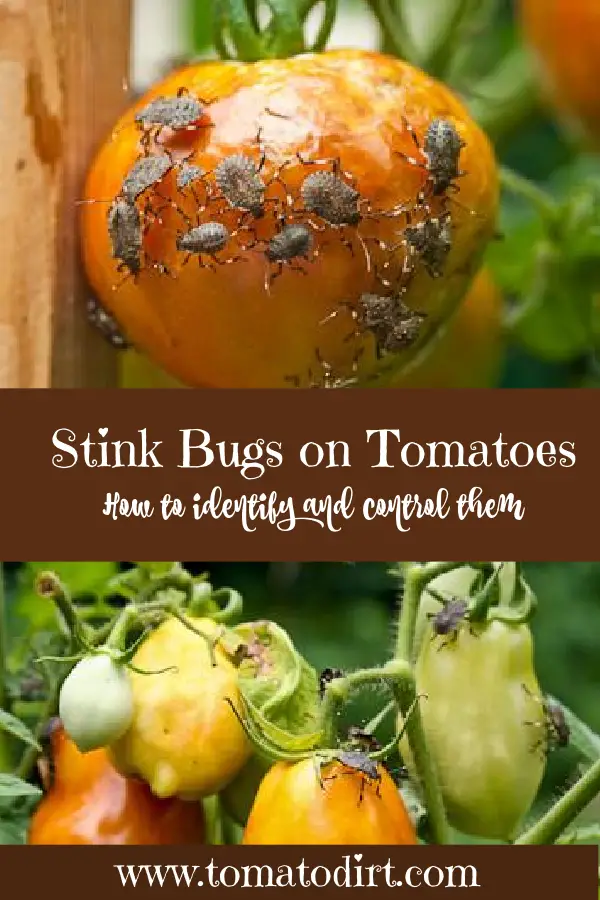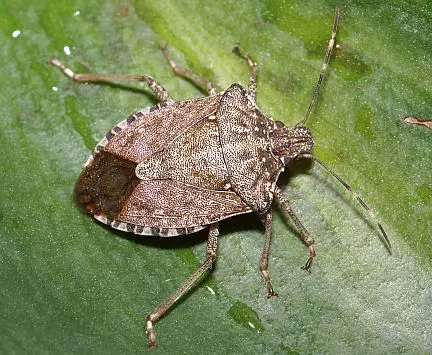Stink Bugs: How to Identify and Control them on Tomatoes
Since 2010, Tomato Dirt has garnered 4.8+ million views, making it the web’s leading online source for growing tomatoes in the home garden. Award-winning writer and Tomato Dirt owner Kathy Widenhouse has helped thousands of home gardeners grow healthier tomatoes. Be one of them when you get Tomato Dirt’s Growing Guide here.
Stink bugs (sometimes called “shield bugs”) are pests that infest tomato plants and destroy fruit.
There are more than 200 species in North America, all members of the pentatomidae insect family.
When threatened, these pests expel a repellent odor from their thoracic gland for which they are named.
In short, they stink.
What does the stink bug look like?
Shape: shield-like
Color: most are variations of brown or green
Markings: different species can have yellow, red, or pink markings
Size: about ½ inch long
What do they do to plants?
- These pests insert their snouts underneath tomato skin. The enzyme they leave at the sting point turns that area of the tomato into liquid. The bug then drinks the liquid.
- Sting points produce dark pinprick marks on the tomato.
- Discolored areas appear on tomatoes where fluid is removed. They’re often white, yellowish or light green. Damage can appear knot-like.
When do they do their work?
Stink bugs are in their adult stage when they attack tomatoes.
How can you control stink bugs?
The best control measure is prevention (see below). Take other steps to keep these pests away from your tomatoes.
What is the stink bug's life cycle?
Our insect friend follows a typical three-stage metamorphosis: egg, nymph, and adult.
- Adults lay eggs in early spring (March and April) on plant stems and undersides of leaves.
- When hatched, nymphs move through 5 developmental stages over the course of 4-5 weeks.
- Adults overwinter in garden debris and leaves, then lay eggs for the next cycle.
How can you prevent them from infesting your tomato patch next season?
- Keep weeds down. Stink bugs hide in dense foliage. By removing as many weeds and unnecessary garden foliage as possible during the growing season, you can take away places for them to live and hide.
- Remove debris. After your last harvest, destroy weeds that could become an overwintering habitat for adult bugs. Remove and destroy affected plants at the end of the season.
- Space plants. When setting out seedlings in the garden next spring, allow extra space in between tomato plants. Space gives extra circulation and provides fewer places for bugs to hide and grow.
What else is important to know about these pests?
- Stink bugs dislike heat and migrate from south to north when temperatures rise.
- However, longer growing seasons in the south allow them to reproduce more frequently. That means infestations are longer in warmer regions. If winter is mild, adult bugs will continue to be active.
- Bugs are attracted to light. They will hover around outdoor lights and even more indoors during summer evenings.
More tomato pests
How to identify tomato pests and control them ...
How to Identify These 13 Common Bugs on Tomato Plants ...
Aphids on tomato plants: how to identify and control them ...
Tomato hornworm: how to identify and control it ...
Tomato fruitworms: how to identify and control them ...
Tomato worms-cutworms: keep them away with stem collars ...
Pests that attack tomatoes in pots ...
How to identify and control indoor tomato pests ...
Get more tips on our Tomato Pests Pinterest board.
Return from Stink Bugs to Tomato Dirt home
As an Amazon Associate and Rakuten Advertising affiliate I earn from qualifying purchases.
SHARE THIS PAGE:
FREE! 10 Must-Know Tomato Growing Tips: 20-page guide
Get yours here:






New! Comments
Have your say about what you just read! Leave a comment in the box below.